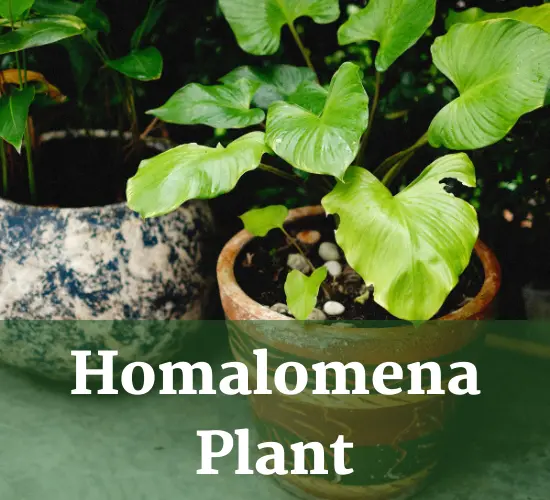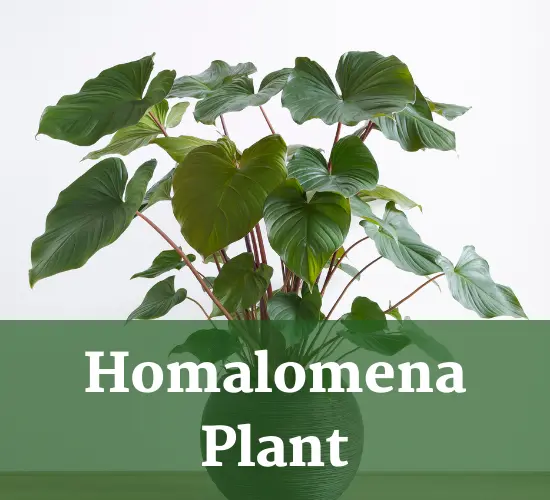Table of Contents
Homalomena Care
In today’s fast-paced world, many individuals strive for a sense of freedom and flexibility in their lives. One way to bring a touch of nature into our homes while maintaining a low-maintenance lifestyle is through the use of houseplants.
The Homalomena Emerald Gem, a compact tropical plant native to Asia and South America, offers the perfect solution. With its stunning tropical beauty and ability to thrive in small spaces, Homalomena Emerald Gem is an ideal choice for those seeking to add a touch of the exotic to their homes.
This plant flourishes in warm temperatures, high humidity, and bright indirect light, making it suitable for indoor environments. Its compact size allows it to fit seamlessly into any space, from apartments to offices, without taking up valuable room.
While Homalomena Emerald Gem may be visually captivating, it is also a low-maintenance plant that requires minimal care. Regular watering is only necessary when the top 50% of the soil has dried out, ensuring that it can withstand periods of neglect. Additionally, a monthly feeding with a diluted general houseplant fertilizer during the spring and summer months will provide the necessary nutrients for healthy growth. However, it is crucial to note that this plant is toxic if ingested, so precautions should be taken, especially in households with pets or small children.
Plant Characteristics

Homalomena Emerald Gem is a compact tropical houseplant that thrives indoors and has a similar appearance to a hosta plant. It is known for its lush, green foliage and its ability to adapt well to indoor environments.
The Homalomena growth rate is relatively slow, making it an ideal choice for those who prefer a low-maintenance plant. With proper care, it can reach a height of about 1-2 feet, making it perfect for small spaces.
When it comes to Homalomena propagation, there are a few different methods that can be used. One common method is division, where the plant is carefully separated into smaller sections, each containing a portion of the root system. These divisions can then be potted up individually and cared for until they establish roots and begin to grow.
Another method is through stem cuttings, where a healthy stem is cut and placed in water or moist soil until roots develop. Once the roots are established, the cutting can be potted up and treated like a mature plant. Both of these propagation methods are relatively easy and can be done successfully by even beginner gardeners.
Ideal Growing Conditions
Optimal growing conditions for the Homalomena plant involve providing warm temperatures, high humidity levels, and bright indirect light, which are believed to promote healthy growth and prevent leaf damage.
The Homalomena thrives in warm temperatures ranging from 65 to 85 degrees Fahrenheit (18 to 29 degrees Celsius). It is important to avoid exposing the plant to temperatures below 60 degrees Fahrenheit (15 degrees Celsius), as this can cause damage to the foliage.
In terms of humidity requirements, the Homalomena prefers high levels of humidity. This can be achieved by placing the plant in a well-ventilated area with a humidity level of around 60% to 70%. Additional humidity can be provided through methods such as misting the leaves or using a humidifier.
In terms of light, the Homalomena plant prefers bright indirect light. It can tolerate lower light conditions, but direct sunlight should be avoided as it can lead to leaf burn. Placing the plant near a window with filtered sunlight or using sheer curtains can help provide the ideal lighting conditions.
It is important to note that Homalomena is a tropical plant that thrives indoors, making it suitable for homes and offices with controlled environments.
By providing the Homalomena plant with the ideal growing conditions of warm temperatures, high humidity levels, and bright indirect light, you can ensure the plant’s healthy growth and enhance its compact tropical beauty in your home.
Common Care Issues

One common care issue for this plant involves drooping leaves, which may indicate an underlying problem such as overwatering, underwatering, or a lack of humidity. It is important to assess watering habits when dealing with drooping leaves.
Overwatering can lead to root rot, causing the roots to become waterlogged and unable to absorb nutrients properly. On the other hand, underwatering can cause the plant to become dehydrated, resulting in wilting and drooping leaves. To address this issue, it is recommended to check the moisture level of the soil before watering and adjust the frequency accordingly.
Additionally, providing adequate humidity through misting or using a humidifier can help prevent drooping leaves caused by a lack of moisture in the air.
Yellowing leaves is another common care issue that may occur with Homalomena plants. There are several reasons why the leaves may turn yellow, including cold temperatures, excessive moisture, or dryness.
Cold temperatures can cause the plant to go into shock and result in yellowing leaves. It is important to keep the plant away from drafty areas and ensure the temperature remains within the optimal range of 65–85 degrees Fahrenheit.
Excessive moisture can lead to root rot, which in turn causes the leaves to turn yellow. On the other hand, dryness can cause the plant to become dehydrated and result in yellowing leaves as well. To address this issue, it is important to maintain a consistent watering schedule and avoid both overwatering and underwatering.
Providing proper drainage and allowing the top 50% of the soil to dry out between waterings can help prevent yellowing leaves.
Frequently Asked Questions
Is the Homalomena Emerald Gem a pet-friendly plant?
The Homalomena Emerald Gem is not pet-friendly, as it is toxic if ingested.
Can Homalomena be propagated easily?
Easy propagation methods for Homalomena include stem cuttings or division. Cut a healthy stem with a few leaves and place it in a well-draining soil mix. Provide bright indirect light and maintain a temperature of 65–85 degrees.
How often should I repot my Homalomena plant?
The repotting frequency for a Homalomena plant depends on its growth rate and signs of rootboundness. Signs of rootboundness include roots circling the pot or emerging from the drainage holes. Repot when necessary to provide sufficient space for root growth.
Can Homalomena be grown in a terrarium or enclosed container?
Growing Homalomena in a terrarium or enclosed container requires careful consideration. While it can thrive in small spaces, it needs adequate ventilation and humidity. Place it in a well-lit area, avoid direct sunlight, and ensure proper watering and fertilization for optimal care.
Are there any specific pests or diseases that commonly affect the Homalomena plant?
Common pests and diseases that commonly affect Homalomena plants include spider mites, mealybugs, and root rot. To prevent these issues, ensure proper watering, humidity levels, and regular inspections for pests. Treat with insecticidal soap or neem oil if necessary.
conclusion
In conclusion, Homalomena Emerald Gem is an easy-to-care-for, compact tropical plant that brings a touch of freedom and tropical charm to any home. Its ability to thrive in small spaces, combined with its low-maintenance requirements, makes it an excellent choice for individuals seeking a houseplant that requires minimal attention. So, why not bring a touch of the tropics into your home and enjoy the beauty and freedom that the Homalomena Emerald Gem has to offer?